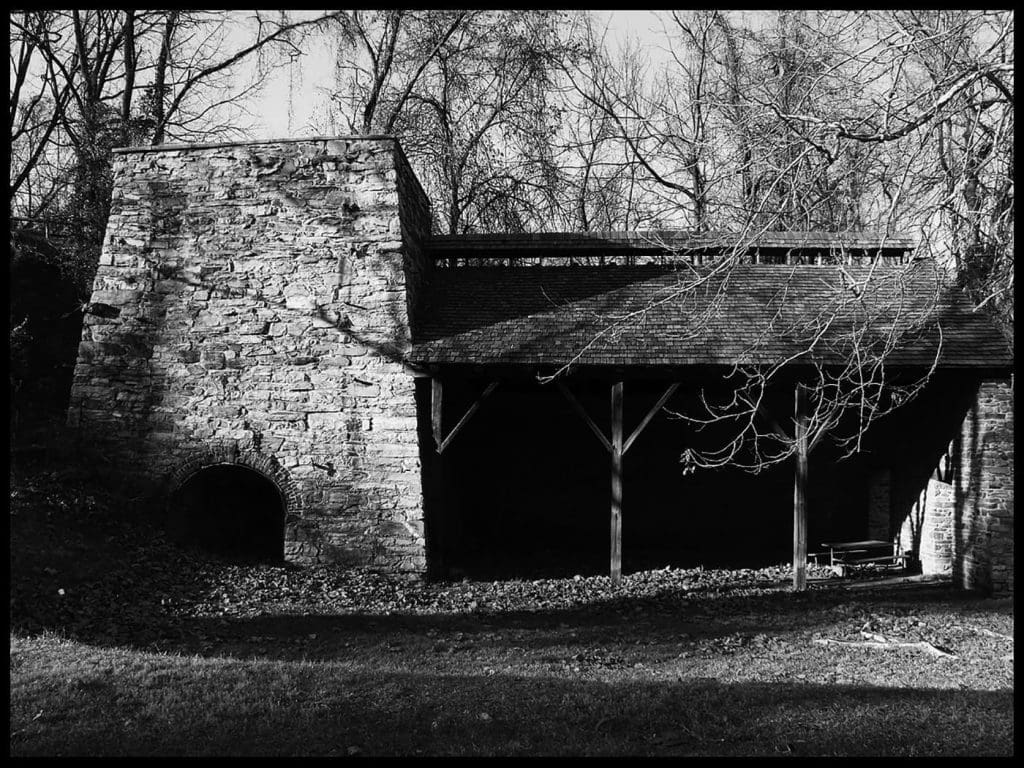In August of 2017, EAC Archaeology, Inc. entered into a sub-award agreement with Johns Hopkins University (JHU) under the project entitled “Scholarly Inquiry, Public Outreach: The Program in Museums and Society at JHU” funded under a grant from the Andrew W. Mellon Foundation. Elizabeth Comer, Jane Seiter, and Robert Wanner, staff members from EAC Archaeology, Inc. designed and taught the course “Heritage at Work” (AS.389.336) in the Program in Museums and Society in Fall 2017 under this grant.
The primary goal of this course was to guide the students, through lectures, discussions, and workshops, in the preparation of exhibits (cases and signage) for the new Museum of the Ironworker in Catoctin Furnace, Maryland which focuses on the historic ironmaking community of Catoctin Furnace. The 1820s stone cottage that houses the museum is an important exemplar of the early nineteenth-century expansion of the ironmaking community of Catoctin Furnace. Its setting within a National Register Historic District that maintains its original pre-Revolutionary layout contributes to its cultural significance. The museum’s goal to illuminate the long-neglected history of enslaved workers in the industrial history of the US augments the cottage’s value as a historic site.
The course aimed to teach students how to develop a budget for, design, and assemble museum and other exhibitions focused on heritage tourism; to develop a better understanding of how artifacts make their way from archaeological excavations to museum exhibitions; and to understand the relationship between archaeology, public outreach, community involvement, and interpretative exhibitions. To hone these skills, students wrote critiques of local museum exhibitions; and developed exhibition briefs, interpretative frameworks, and design plans for original exhibitions to be installed at the Museum of the Ironworker (see Appendix A). These exhibits were meant to make use of the collection of approximately 20,000 artifacts recovered from archaeological excavations at one of the worker houses at Catoctin Furnace, including clothing, toys, railroad spikes,
The seven exhibit designs were refined by a JHU student intern during the spring semester and summer session 2018. Working with a professional design firm (Paris Design), the seven exhibits were merged into a cohesive design through a bubble plan process (see Appendix B). The JHU student intern was instrumental in this process and served as the main contact.
Students enrolled in the class designed seven exhibits for the museum. Students were responsible for writing an exhibition brief, an interpretative plan, and a final design plan, including digital versions of signage, for each of these exhibits. Each of them is discussed in detail below.
Casting Light on the Furnace was designed to be placed in the new casting shed that is attached to the historic stack at Catoctin Furnace. The exhibit highlights the process of historic ironmaking from start to finish and connects it to the modern industry. It describes the various jobs of workers at Catoctin Furnace and shows some of the negative impacts the furnace had on the workers and their environment. This exhibit will be accessible to visitors whether they visit the Museum of the Ironworker or not.
Clothing at Catoctin showcases the nineteenth-century worker clothing that was recovered from the roof area of one of the houses at Catoctin Furnace. The exhibit utilizes the historic clothing (on mannequins) and historic photographs as touchstones for understanding the lives of workers at Catoctin Furnace. Reproductions of clothing items are utilized in the exhibit so that visitors can interact with the material culture.
Daily Life at Catoctin Furnace follows the daily life of historic families living in the ironmaking village through documentary evidence and archaeological evidence. The exhibit utilizes excerpts from historic ledgers from the Catoctin Furnace company store. A “loose floorboard” installed next to the panels demonstrates how the historic artifacts were deposited and later discovered.
Evolving Transportation Technology at Catoctin Furnace Exhibit tells the story of the introduction and the effects of the railroad in Catoctin Furnace. The exhibit follows the transportation networks of the furnace from the primitive mule and cart, to the Dinky Railroad, and finally to the Monocacy Valley Railroad, which transported the finished products from Catoctin Furnace to the market. The exhibit utilizes a display functional model railroads, augmented by historic photographs and historic railroad spikes.
Leisure: Culture and Celebrations in an Iron Working Village examines the role of children’s toys and games, holidays and celebrations, and alcohol and tobacco in the industrial setting of Catoctin Furnace. The exhibit makes use of several historic artifacts in two display cases, as well as reproductions of the toys that are accessible to visitors. Interpretative text emphasizes the differences in leisure based on race, class, and gender.
Natural Resources at Catoctin Furnace focuses on the natural resources that made Catoctin Furnace attractive to early iron manufacturing. The exhibit utilizes models, displays, photographs, sound, and maps that demonstrate the importance of the four most important elements – water, wood, iron ore, and limestone. The exhibit makes use of a window in the building to direct the visitor’s attention to the actual elements in the landscape.
Slavery at Catoctin Furnace highlights the role of slavery at Catoctin Furnace, as informed by the African American cemetery site and the ongoing study of the remains of several individuals from that cemetery. The exhibit introduces the visitor to slavery at the furnace, contextualizes the institution within the environment, and shares information about the archaeological excavations in the cemetery in the 1970s and the new skeletal analysis underway in cooperation with the Smithsonian Institute in the 2010s.
